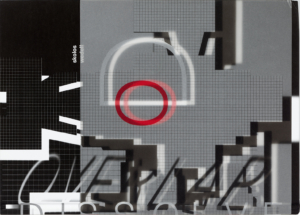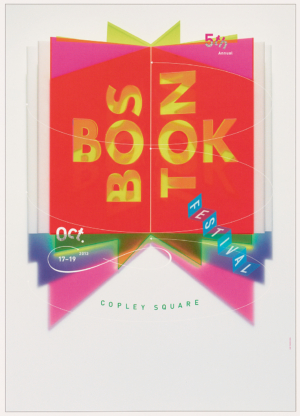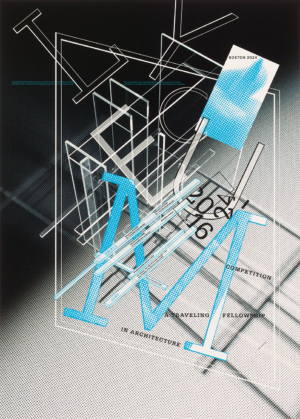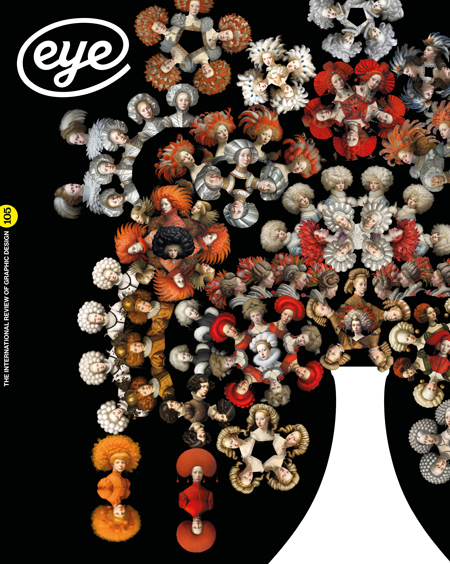Autumn 2023
One brain, four eyes
Skolos+Wedell, Overlap / Dissolve
Designed by Nancy Skolos and Tom Wedell, Oro Editions, $50
Nancy Skolos and Tom Wedell met as students at the Cranbrook Academy of Art in Bloomfield Hills, Michigan in 1975, where Wedell was studying photography and Skolos graphic design. Their long partnership, in work and in life (they later married), started almost straight away. For 40-plus years, they have worked side by side as Skolos+Wedell creating singular and idiosyncratic graphic design that blends typography and photography, analogue and digital processes, and two- and three-dimensions. This body of work is collected in the duo’s highly personal new monograph, Overlap / Dissolve.
Cover of Overlap / Dissolve, photographed with short tracing paper dust jacket.
Top. Silkscreen poster for Lyceum Fellowship, Student Architecture Competition, 2008.

Structured chronologically, each decade from the 1980s to the 2020s is given a chapter showing the couple’s work across mediums and clients, with a special emphasis on the studio’s poster work. Their career parallels the rise of digital technology in the design field but the paradox in their work is that it looked digital despite being created with analogue processes. Clients, they write, would be surprised to learn they were not using computers in those early years. They were building models, constructing sculptures, creating collages, all to be photographed as a fully formed composition that was printed as a poster. The result looks as if it were made using early desktop publishing software but was done by hand and in camera. In fact, the best parts of this book are the behind-the-scenes photographs of the pair building these compositions by hand, on the floor, with a camera hanging overhead waiting to capture the design.
What’s striking in seeing this work collected in one place is the near-immediate clarity of vision and voice. It feels, at times, as if this partnership was born fully formed. The book opens with five short essays on the principles that guide their practice and frame the book: ‘Modernism and Technology’, ‘Two and Three Dimensions’, ‘Processes and Materials’, ‘Collage and Composition’, and ‘Type and Image’. It’s in these essays that the influence of Cranbrook, perhaps, is most evident as they were students under Katherine and Michael McCoy who pioneered a layered, postmodern aesthetic rooted in theory and emerging technologies. Yet to flip through the pages of Overlap / Dissolve, one sees how the duo took these concepts and made something new. Even today, their work looks unlike anything else.
Digitally printed poster for the Boston Book Festival, 2013.

Its singularity is attributed, perhaps, to the marriage of photography and typography. ‘What Skolos and Wedell do in their work is to blur the distinction between photography and design,’ wrote Mike Hicks in a profile of the studio in Eye 8, ‘To understand the nature of their achievement, one must frame it in the context of two separate and mutually exclusive sensibilities within the arena of design communications in the United States: academic theory and technological wizardry.’ The book opens and closes with an extended dialogue between Skolos and Wedell that covers their process, partnership, and evolution as designers. This conversation corrects the myth that Wedell handled the photography and Skolos the typography. For Skolos and Wedell, there is no separation between the two; they describe their collaboration as ‘one brain with two bodies’.
Alongside the studio, both Skolos and Wedell have taught at the Rhode Island School of Design, with Skolos serving as head of graphic design from 2003-06 and again from 2011-13. (She was also Dean of Architecture and Design from 2014-17.) If there is one thing missing from Overlap / Dissolve, it is the influence teaching has had on their work and practice.
Digitally printed poster for Lyceum Fellowship, Student Architecture Competition, 2016.

Although Skolos and Wedell were students at Cranbrook when it was a hotbed for experimental, postmodern design, it would be reductive to simply group them with other Cranbrook alums or the postmodernists of the era. Collected here, the range of influences, processes and evolution is on full display. What becomes apparent throughout Overlap / Dissolve is that Skolos and Wedell’s work is wholly of their time and simultaneously timeless. The work feels just as revolutionary today as it did 40 years ago.
Jarrett Fuller, designer, writer, educator, North Carolina, US
Buy ‘Overlap / Dissolve’ at the Eye magazine bookshop
‘Techno cubists’ in Eye 8
First published in Eye no. 105 vol. 27, 2023
Eye is the world’s most beautiful and collectable graphic design journal, published for professional designers, students and anyone interested in critical, informed writing about graphic design and visual culture. It is available from all good design bookshops and online at the Eye shop, where you can buy subscriptions and single issues.

